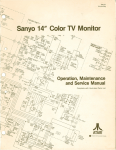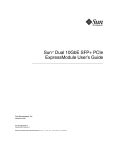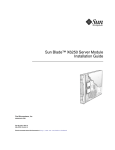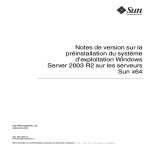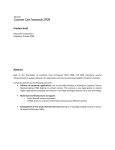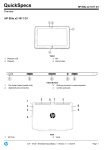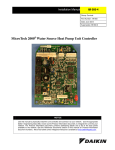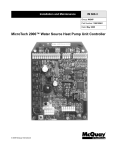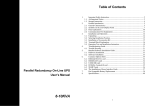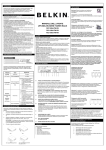Download Sun Dual 10GbE Fabric Expansion Module User`s Guide
Transcript
Sun™ Dual 10GbE Fabric Expansion Module User’s Guide Sun Microsystems, Inc. www.sun.com Part No. 820-4448-13 January 2009, Revision A Submit comments about this document at: http://docs.sun.com/app/docs/ Copyright 2009 Sun Microsystems, Inc., 4150 Network Circle, Santa Clara, California 95054, U.S.A. All rights reserved. Sun Microsystems, Inc. has intellectual property rights relating to technology that is described in this document. In particular, and without limitation, these intellectual property rights may include one or more of the U.S. patents listed at http://www.sun.com/patents and one or more additional patents or pending patent applications in the U.S. and in other countries. This document and the product to which it pertains are distributed under licenses restricting their use, copying, distribution, and decompilation. No part of the product or of this document may be reproduced in any form by any means without prior written authorization of Sun and its licensors, if any. Third-party software, including font technology, is copyrighted and licensed from Sun suppliers. Parts of the product may be derived from Berkeley BSD systems, licensed from the University of California. UNIX is a registered trademark in the U.S. and in other countries, exclusively licensed through X/Open Company, Ltd. Sun, Sun Microsystems, the Sun logo, Java, docs.sun.com, Solaris, and Sun Dual 10GbE Fabric Expansion Module are trademarks or registered trademarks of Sun Microsystems, Inc., and its subsidiaries, in the U.S. and in other countries. All SPARC trademarks are used under license and are trademarks or registered trademarks of SPARC International, Inc. in the U.S. and in other countries. Products bearing SPARC trademarks are based upon an architecture developed by Sun Microsystems, Inc. U.S. Government Rights—Commercial use. Government users are subject to the Sun Microsystems, Inc. standard license agreement and applicable provisions of the FAR and its supplements. DOCUMENTATION IS PROVIDED "AS IS" AND ALL EXPRESS OR IMPLIED CONDITIONS, REPRESENTATIONS AND WARRANTIES, INCLUDING ANY IMPLIED WARRANTY OF MERCHANTABILITY, FITNESS FOR A PARTICULAR PURPOSE OR NON-INFRINGEMENT, ARE DISCLAIMED, EXCEPT TO THE EXTENT THAT SUCH DISCLAIMERS ARE HELD TO BE LEGALLY INVALID. Copyright 2009 Sun Microsystems, Inc., 4150 Network Circle, Santa Clara, Californie 95054, États-Unis. Tous droits réservés. Sun Microsystems, Inc. possède les droits de propriété intellectuels relatifs à la technologie décrite dans ce document. En particulier, et sans limitation, ces droits de propriété intellectuels peuvent inclure un ou plusieurs des brevets américains listés sur le site http://www.sun.com/patents ,un ou les plusieurs brevets supplémentaires ainsi que les demandes de brevet en attente ou ses filiales aux les États-Unis et dans d’autres pays. Ce document et le produit auquel il se rapporte sont protégés par un copyright et distribués sous licences, celles-ci en restreignent l’utilisation, la copie, la distribution, et la décompilation. Aucune partie de ce produit ou document ne peut être reproduite sous aucune forme, par quelque moyen que ce soit, sans l’autorisation préalable et écrite de Sun et de ses bailleurs de licence, s’il y en a. Tout logiciel tiers, sa technologie relative aux polices de caractères, comprise, est protégé par un copyright et licencié par des fournisseurs de Sun. Des parties de ce produit peuvent dériver des systèmes Berkeley BSD licenciés par l’Université de Californie. UNIX est une marque déposée aux États-Unis et dans d’autres pays, licenciée exclusivement par X/Open Company, Ltd. Sun, Sun Microsystems, le logo Sun, Java, docs.sun.com, Solaris, et Sun Dual GbE Fabric Expansion Module sont des marques de fabrique ou des marques déposées de Sun Microsystems, Inc., et ses filiales, aux États-Unis et dans d’autres pays. Toutes les marques SPARC sont utilisées sous licence et sont des marques de fabrique ou des marques déposées de SPARC International, Inc. aux États-Unis et dans d’autres pays. Les produits portant les marques SPARC sont basés sur une architecture développée par Sun Microsystems, Inc. LA DOCUMENTATION EST FOURNIE "EN L’ÉTAT" ET TOUTES AUTRES CONDITIONS, DÉCLARATIONS ET GARANTIES EXPRESSES OU TACITES SONT FORMELLEMENT EXCLUES DANS LA LIMITE DE LA LOI APPLICABLE, Y COMPRIS NOTAMMENT TOUTE GARANTIE IMPLICITE RELATIVE À LA QUALITÉ MARCHANDE, À L’APTITUDE À UNE UTILISATION PARTICULIÈRE OU À L’ABSENCE DE CONTREFAÇON. Contents Preface 1. v Sun Dual 10GbE Fabric Expansion Module Overview Shipping Kit Contents Product Description 1 1 2 Sun Dual 10GbE Fabric Expansion Module Features Hardware and Software Requirements 2 3 Sun Dual 10GbE Fabric Expansion Module Support on Sun Blade X6250 Server Module 3 Check Hardware Release Before Installing CPLD Update 2. Installing and Setting Up the nxge Driver nxge Driver Overview 5 5 nxge Driver for Solaris Platforms Required Patches 4 5 6 Downloading and Installing the Driver on a Linux Platform ▼ To Download the Driver on a Linux Platform 6 ▼ To Remove the Driver From a Linux Platform 8 Downloading and Installing the Windows OS Drivers 8 6 Hot-Swapping a Sun Blade 6000 10GbE Multi-Fabric NEM With Windows OS Driver Installed 9 iii Replacing a 10GbE Multi-Fabric NEM 3. Installing the Fabric Expansion Module Installing the FEM ▼ 4. 9 13 13 To Install the FEM 13 Configuration Information 15 Sun Dual 10GbE XFP PCIe ExpressModule User’s Guide URL A. Specifications 17 Performance Specifications Physical Characteristics B. Power Requirements 18 Diagnostic Software 19 18 18 SunVTS Diagnostic Software 19 Updating SunVTS to Recognize the FEM ▼ To Update SunVTS to Recognize the FEM Using the SunVTS netlbtest ▼ Index iv 20 To Use the netlbtest 20 21 23 Sun Dual 10GbE Fabric Expansion Module User’s Guide • January 2009 20 15 Preface This guide provides instructions for installing both the hardware and software for Sun Dual 10GbE Fabric Expansion Module (FEM). This guide also describes how to configure the nxge driver, which controls the FEM. These instructions are designed for enterprise system administrators with experience installing network hardware and software. Note – In this document the term x86 means the following: • x86 refers to the larger family of 64-bit and 32-bit x86 compatible products. • x64 points out specific 64-bit information about AMD64 or EM64T systems. • 32-bit x86 points out specific 32-bit information about x86 based systems. For supported systems, see the “Hardware and Software Requirements” on page 3. v How This Document Is Organized Chapter 1 provides an overview of the Sun Dual 10GbE Fabric Expansion Module and lists the hardware and software requirements. Chapter 2 describes how to download, install, and remove the software for both Solaris and Linux environments, and lists the required driver patches. Chapter 3 describes how to install the Sun Dual 10GbE Fabric Expansion Module in your system. Chapter 4 refers to the Sun Dual 10GbE XFP PCIe ExpressModule User’s Guide (part number 820-1606) for the following information: ■ Configuring the Network ■ Configuring the nxge Device Driver Parameters ■ Configuring the Jumbo Frames Feature ■ Configuring Link Aggregation ■ Configuring VLANs Appendix A lists the specifications for the Sun Dual 10GbE Fabric Expansion Module. Appendix B provides an overview of the SunVTS™ diagnostic application and instructions for updating the SunVTS software to recognize the FEM. Using UNIX Commands This document might not contain information about basic UNIX® commands and procedures such as shutting down the system, booting the system, and configuring devices. Refer to the following for this information: ■ Software documentation that you received with your system ■ Solaris Operating System documentation, which is at: http://docs.sun.com vi Sun Dual 10GbE Fabric Expansion Module User’s Guide • January 2009 Shell Prompts Shell Prompt C shell machine-name% C shell superuser machine-name# Bourne shell and Korn shell $ Bourne shell and Korn shell superuser # Typographic Conventions Typeface* Meaning Examples AaBbCc123 The names of commands, files, and directories; on-screen computer output Edit your.login file. Use ls -a to list all files. % You have mail. AaBbCc123 What you type, when contrasted with on-screen computer output % su Password: AaBbCc123 Book titles, new words or terms, words to be emphasized. Replace command-line variables with real names or values. Read Chapter 6 in the User’s Guide. These are called class options. You must be superuser to do this. To delete a file, type rm filename. * The settings on your browser might differ from these settings. Preface vii Related Documentation The documents listed as online are available at: http://docs.sun.com/app/docs/prod/dual.fab.exp Application Title Part Number Format Location Release Notes Sun Dual 10GbE Fabric Expansion Module Release Notes 820-4449 PDF HTML Online Getting started Sun Dual 10GbE Fabric Expansion Module Getting Started Guide 820-4486 Printed In product shipping kit Safety and compliance Important Safety Information for Sun Hardware Systems 816-7190 PDF HTML In product shipping kit Documentation, Support, and Training Sun Function URL Documentation http://docs.sun.com/app/docs Support http://www.sun.com/support/ Training http://www.sun.com/training/ Sun Welcomes Your Comments Sun is interested in improving its documentation and welcomes your comments and suggestions. You can submit your comments by going to: http://docs.sun.com/app/docs/ Please include the title and part number of your document with your feedback: Sun Dual 10GbE Fabric Expansion Module User’s Guide, part number 820-4448-13 viii Sun Dual 10GbE Fabric Expansion Module User’s Guide • January 2009 CHAPTER 1 Sun Dual 10GbE Fabric Expansion Module Overview This chapter provides an overview of the Sun Dual 10GbE Fabric Expansion Module (FEM), including: ■ “Shipping Kit Contents” on page 1 ■ “Product Description” on page 2 ■ “Hardware and Software Requirements” on page 3 ■ “Sun Dual 10GbE Fabric Expansion Module Features” on page 2 Shipping Kit Contents The carton in which your Sun Dual 10GbE Fabric Expansion Module was shipped should contain the following items: ■ Sun Dual 10GbE Fabric Expansion Module ■ Sun Dual 10GbE Fabric Expansion Module Getting Started Guide Note – Sun 10GbE SFP+ SR optical tranceivers are available for order with part number, X5561A-Z. 1 Product Description The Sun Dual 10GbE Fabric Expansion Module is an x8 lane PCI-Express 10-Gigabit Ethernet card using the Sun ASIC with SFP+ based 10-Gigabit Ethernet optics. Sun Dual 10GbE Fabric Expansion Module Features The Sun Dual 10GbE Fabric Expansion Module provides the following features: 2 ■ Supports two full-duplex 10-Gigabit Ethernet interfaces from the Sun Blade 6000 10GbE Multi-fabric Network Express Module of the Sun Blade 6000 Modular Systems. ■ Small form factor 10-Gigabit Ethernet pluggable (SFP+) optical transceivers with duplex LC fiber connectors in the Sun Blade 6000 10GbE Multi-fabric Network Express Module ■ IEEE 802.3ae 2002-compliant ■ Uses Sun ASIC and software for innovative throughput networking design ■ Networking I/O virtualization supporting Solaris LDoms 1.0 software ■ Hardware-based flow classification for extending parallelism and virtualization to networking ■ Up to 16 receive DMA channels and up to 24 transmit DMA channels, multiple receive and transmit descriptor rings, and dedicated networking hardware resources (DMA, interrupts, buffer, and more) for each thread or strand ■ CPU/thread affinity and CPU load balancing at L1, L2, L3, and L4 ■ Jumbo Frames support (up to 9KBytes) ■ IPv4, IPv6, and IPMP support ■ TCP and UDP checksum and CRC32C support ■ IEEE 802.1Q VLAN support Sun Dual 10GbE Fabric Expansion Module User’s Guide • January 2009 Hardware and Software Requirements Before installing the FEM, ensure that your system meets the hardware and software requirements in TABLE 1-1. TABLE 1-1 Hardware and Software Requirements for Sun x64 Servers Requirements Hardware or Software Operating system • • • • • 10GbE network express module (NEM) Sun Blade 6000 10GbE Multi-fabric Network Express Module Sun Blade Server Module • Sun Blade X6250 Server Module (375-3501-06 or newer). This part number is printed on the motherboard, and can be read from the ELOM. • Sun Blade X6450 Server Module Solaris 10 8/07 Operating System Redhat Enterprise Linux (RHEL) AS4.5 (32- and 64-bit) RHEL AS4.6 (64-bit) SuSE Linux Enterprise Server (SLES) 10 SP1 (64-bit) Windows Server 2008 Enterprise Edition (32-bit and 64-bit miniport driver) The Sun Blade 6000 10GbE Multi-fabric Network Express Module is hot-pluggable and connects to the rear of the Sun Blade 6000 Modular System chassis. The NEM is a pass-through device, which connects the network device of each Sun Blade server module from the chassis mid-plane to an RJ-45 Ethernet port on the NEM. The Sun Blade 6000 10GbE Multi-fabric Network Express Module (marketing part number X4251) NEM retains the pass-through network connections and adds circuitry to provide multiple SAS connections to hard disk drives. Sun Dual 10GbE Fabric Expansion Module Support on Sun Blade X6250 Server Module The Sun Dual 10GbE Fabric Expansion Module (FEM) is supported only on the Sun Blade X6250 server motherboard with part number 375-3501-06 or newer. The Sun Dual 10 GbE FEM also requires CPLD version 231. To find the part number, either use the ELOM, or look for the number printed on the motherboard itself. Chapter 1 Sun Dual 10GbE Fabric Expansion Module Overview 3 Check Hardware Release Before Installing CPLD Update Before installing CPLD version 231 on the Sun Blade X6250 server, check the part number on the motherboard. It must be 375-3501-06 or newer. If you have a motherboard with a different part number, do not install CPLD version 231. To find the part number, either use the ELOM, or look for the number printed on the motherboard itself. 4 Sun Dual 10GbE Fabric Expansion Module User’s Guide • January 2009 CHAPTER 2 Installing and Setting Up the nxge Driver This chapter explains how to download and install the nxge driver. This chapter contains the following sections: ■ “nxge Driver Overview” on page 5 ■ “nxge Driver for Solaris Platforms” on page 5 ■ “Downloading and Installing the Driver on a Linux Platform” on page 6 ■ “Downloading and Installing the Windows OS Drivers” on page 8 nxge Driver Overview The nxge Gigabit Ethernet driver (nxge[7D]) is a multithreaded, loadable, clonable, GLD-based STREAMS driver. The nxge driver is managed by the dladm(1M) command-line utility, which allows VLANs to be defined on top of nxge instances and for nxge instances to be aggregated. See the dladm(1M) man page for more details on configuring the data-link interfaces and link aggregations. nxge Driver for Solaris Platforms If your system uses the Solaris 10 8/07 Operating System, the nxge device driver is bundled with the operating system. However, you must download and install patches for Sun Dual 10GbE Fabric Expansion Module support. 5 Required Patches This section lists the latest required patches. Note – Always check for the latest revision of the patch, -01, -02, and so on. Patch ID Description 119255-53 Prerequisite patch for Kernel Patch 127128-11 126424-03 Prerequisite patch for Kernel Patch 127128-11 127756-01 Prerequisite patch for Kernel Patch 127128-11 127128-11 Kernel patch for Solaris 10 8/07 OS 138049-02 x86 hot swap support for the Sun Blade 6000 10GbE Multi-fabric Network Express Module Downloading and Installing the Driver on a Linux Platform ▼ To Download the Driver on a Linux Platform 1. Log in to your system. 2. Download the driver RPM for your operating system: https://cds.sun.com/is-bin/INTERSHOP.enfinity/WFS/CDS-CDS_SMISite/en_US/-/USD/ViewProductDetail-Start?ProductRef= Sunx8Exp-EAD-1.0-G-F@CDS-CDS_SMI For example, the file will look similar to the following: sun_10_Gigabit_Ethernet_driver_update_xx.zip After unzipping this file, go to the Linux directory. 6 Sun Dual 10GbE Fabric Expansion Module User’s Guide • January 2009 3. Discover the network interfaces before adding the package by using the ifconfig -a command: # ifconfig -a | grep eth eth0 Link encap:Ethernet eth1 Link encap:Ethernet eth2 Link encap:Ethernet eth3 Link encap:Ethernet HWaddr HWaddr HWaddr HWaddr 00:14:4F:20:F1:DC 00:14:4F:20:F1:DD 00:14:4F:20:F1:DE 00:14:4F:20:F1:DF 4. Use the rpm tool to install the driver on SuSe and RedHat Linux. # rpm -ivh nxge-2.6.9-55.ELsmp-2.1-1.x86_64.rpm Preparing... ########################################### [100%] 1:nxge-2.6.9-55.ELsmp ########################################### [100%] 5. Ensure that the driver is loaded after the RPM installation, enter the following: # lsmod | grep nxge 6. Verify the new network interface instances corresponding to the Sun Dual 10GbE Fabric Expansion Module: # ifconfig -a | grep eth eth0 Link encap:Ethernet eth1 Link encap:Ethernet eth2 Link encap:Ethernet eth3 Link encap:Ethernet eth4 Link encap:Ethernet eth5 Link encap:Ethernet HWaddr HWaddr HWaddr HWaddr HWaddr HWaddr 00:14:4F:20:F1:DC 00:14:4F:20:F1:DD 00:14:4F:20:F1:DE 00:14:4F:20:F1:DF 00:14:4F:6C:78:E8 00:14:4F:6C:78:E9 The Sun Dual 10GbE Fabric Expansion Module instances, eth2 and eth3, appear in the third and fourth lines of the output. 7. Use the ethtool command to check the parameter configurations that apply to the nxge driver: (For 10G) # ethtool -i eth2 driver: nxge version: 2.1.1 firmware-version: RFEM PXE1.49 FCode 3.16 bus-info: 0000:0d:00.0 Chapter 2 Installing and Setting Up the nxge Driver 7 ▼ To Remove the Driver From a Linux Platform ● To remove the driver packages from a Linux platform use the rpm -e command. For example: # rpm -e nxge-2.6.9-55.ELsmp-2.1-1 If driver package removal is attempted when the driver is not loaded, the removal could fail. For example: # rpm -e nxge-2.6.16.46-0.12-smp-2.1-1.x86_64 ERROR: Removing ’nxge’: No such file or directory error: %postun(nxge-2.6.16.46-0.12-smp-2.1-1.x86_64) scriptlet failed, exit status 255 In the case of such failure, use the --noscripts option as follows. # rpm -e --noscripts nxge-2.6.16.46-0.12-smp-2.1-1.x86_64 Downloading and Installing the Windows OS Drivers The Sun Dual 10GbE Fabric Expansion Module supports the Windows Server 2008 Enterprise Edition 32/64-bit miniport driver. For additional Windows driver release information, refer to the Sun Multithreaded 10GbE and QGC Networking Cards Specification for Windows xxx Drivers document. Note – Installing the Windows OS driver changes the hot-swapping procedure for the Sun Blade 6000 10 GbE Multi-Fabric Network Expansion Module. See “Hot-Swapping a Sun Blade 6000 10GbE Multi-Fabric NEM With Windows OS Driver Installed” on page 9. The Sun Dual 10GbE Fabric Expansion Module must be installed before you install the Windows Server 2008 Enterprise Edition miniport driver. Without the Sun Dual 10GbE Fabric Expansion Module installed, the Windows OS driver will not install correctly. 8 Sun Dual 10GbE Fabric Expansion Module User’s Guide • January 2009 To download the Windows OS driver and documentation, go to: https://cds.sun.com/is-bin/INTERSHOP.enfinity/WFS/CDS-CDS_SMI-Si te/en_US/-/USD/ViewProductDetail-Start?ProductRef= Sunx8Exp-EAD-1.0-G-F@CDS-CDS_SMI The zip file looks similar to the following: sun_10_Gigabit_Ethernet_driver_update_xx.zip After unzipping this file, go to Windows directory, which contains the documents and driver: Readme.txt User Manual.pdf Release Notes.txt windows_2008_Releasepackage.zip Sun MulitThreaded 10GbE and QGC Installer.msi Note – Multiple VLANs are not currently supported with the Windows OS driver. Hot-Swapping a Sun Blade 6000 10GbE Multi-Fabric NEM With Windows OS Driver Installed This section explains how to remove an existing 10GbE Multi-Fabric NEM and install another in its place. Caution – Damage to the NEM can occur as the result of careless handling or electrostatic discharge (ESD). Always handle the NEM with care to avoid damage to ESD-sensitive components. To minimize the risk of electrostatic damage, Sun strongly recommends that you use both a workstation antistatic mat and an antistatic wrist strap. Replacing a 10GbE Multi-Fabric NEM If an Multi-Fabric NEM fails, you will need to replace it. Caution – The NEM should be replaced immediately after it fails. Chapter 2 Installing and Setting Up the nxge Driver 9 The Multi-Fabric NEM is a Customer Replaceable Unit (CRU). You replace the entire module. There are no subcomponents that you can replace. You can remove and replace a 10GbE Multi-Fabric NEM from a powered-on chassis using a hot-swap operation, as well as from a powered-off chassis. Caution – Before you remove the NEM from the chassis, you should pause or shut down any active I/O that passes through the NEM. Note – The blue Ready to Remove LED on the NEM is not operational. To help identify a NEM that you plan to remove, you can illuminate the white Locate LED using the proxy CLI. For more information, refer to the Sun Blade 6000 10GbE Multi-Fabric Network Express Module User’s Guide. ▼ To Replace a 10GbE Multi-Fabric NEM Caution – If you are replacing the NEM while power is applied to the chassis, be sure to have a NEM filler panel ready for use before you remove the NEM. The NEM slot must not be left uncovered for more than a minute while power is active in the chassis. 1. Double-click the Safely Remove Hardware icon located at the bottom right of the GUI. 2. Select the device Sun Muiltithreaded 10GbE & QGE Networking Cards #. 3. Click STOP. 4. Confirm it is the correct device click OK. 5. When the GUI reports that it is safe to remove the hardware, click OK. 6. Label all the cables so you can reconnect them in the same location. 7. Disconnect all cables from the NEM. 8. Press together and hold the ejector buttons on both the right and left ejector levers. 9. Open the ejector levers by extending them outward until they stop. 10. Hold the opened ejector levers and pull the NEM out. 11. Insert the new Multi-Fabric NEM into the chassis. 10 Sun Dual 10GbE Fabric Expansion Module User’s Guide • January 2009 12. Reconnect all the cables in their original locations. Chapter 2 Installing and Setting Up the nxge Driver 11 12 Sun Dual 10GbE Fabric Expansion Module User’s Guide • January 2009 CHAPTER 3 Installing the Fabric Expansion Module This chapter describes how to install the Sun Dual 10GbE Fabric Expansion Module in your system and verify that it has been installed correctly. Note – If you are installing the FEM into a machine running the Solaris 10 OS, you must install the software before you install the hardware. Installing the FEM The following instructions describe the basic tasks required to install the FEM inside a blade server. Refer to your system installation or service manual for detailed FEM installation instructions. ▼ To Install the FEM 1. Halt and power off your system. 2. Power off all peripherals connected to your system. 3. Attach the adhesive copper strip of the antistatic wrist strap to the metal casing of the power supply. Wrap the other end twice around your wrist, with the adhesive side against your skin. 4. Remove the main cover of your system. 13 5. Remove the filler cap from the FEM connector. The FEM connector is labeled FEM. 6. Align the FEM card with the connector and support bracket, then seat it carefully into the slot (FIGURE 3-1). FIGURE 3-1 14 Installing the FEM Sun Dual 10GbE Fabric Expansion Module User’s Guide • January 2009 CHAPTER 4 Configuration Information If you require more information about the following topics, refer to the Sun Dual 10GbE XFP PCIe ExpressModule User’s Guide, part number 820-1606. ■ Configuring the Network ■ Configuring the nxge Device Driver Parameters ■ Configuring the Jumbo Frames Feature ■ Configuring Link Aggregation ■ Configuring VLANs Sun Dual 10GbE XFP PCIe ExpressModule User’s Guide URL http://docs.sun.com/app/docs/prod/10gbe.xfp.pcie~10gbe-xfp-pem 15 16 Sun Dual 10GbE Fabric Expansion Module User’s Guide • January 2009 APPENDIX A Specifications This appendix lists the specifications for the Sun Dual 10GbE Fabric Expansion Module. This appendix contains the following sections: ■ “Performance Specifications” on page 18 ■ “Physical Characteristics” on page 18 ■ “Power Requirements” on page 18 17 Performance Specifications TABLE A-1 Performance Specifications Feature Specification Bus type x8 lane PCI Express 1.1 Bus width x8 lane PCI Express Bus speed (x8, encoded rate) 20 Gbit/sec unidirectional; 40 Gbit/sec bidirectional (theoretical) Maximum Ethernet transfer rate 10 Gbps (full-duplex) Optics Optical transceiver is installed in NEM Physical Characteristics TABLE A-2 Physical Characteristics of the ExpressMoudle Dimension Measurement Length 139.7 mm (5.5 inches) Width 21.10 mm (.83 inches) Height 35 mm (1.38 inches) Power Requirements TABLE A-3 18 Environmental Requirements Specification Measurement Power consumption 10.615W RMS typical 14.151W maximum Voltage 12V @ 1.18A maximum (0.885A RMS typical) 3.3V @ 0.032A maximum (0.025A RMS typical) Sun Dual 10GbE Fabric Expansion Module User’s Guide • January 2009 APPENDIX B Diagnostic Software This appendix provides an overview of the SunVTS diagnostic application and instructions for updating the SunVTS software to recognize the Sun Dual 10GbE Fabric Expansion Module. This appendix contains the following sections: ■ “SunVTS Diagnostic Software” on page 19 ■ “Updating SunVTS to Recognize the FEM” on page 20 ■ “Using the SunVTS netlbtest” on page 20 SunVTS Diagnostic Software The SunVTS software executes multiple diagnostic hardware tests from a single user interface. SunVTS is used to verify the configuration and functionality of most hardware controllers and devices. The SunVTS software operates primarily from a graphical user interface, enabling test parameters to be set quickly and easily while a diagnostic test operation is being performed. The SunVTS nettest diagnostic can be used to test all of the networking interfaces on the system, including the interfaces on the FEM. To use the nettest diagnostic, you must have the SunVTS software installed on your system. Refer to your Solaris documentation for installation instructions. Refer to the SunVTS documentation (listed in TABLE B-1) for instructions on how to run and monitor the nettest diagnostic. These SunVTS documents are available online at the following URL: http://www.sun.com/documentation 19 Select the document for the Solaris release on your system. TABLE B-1 SunVTS Documentation Title Description SunVTS User’s Guide Describes the SunVTS diagnostic environment SunVTS Test Reference Manual Describes each SunVTS test (including the nettest) and describes the various test options and command-line arguments SunVTS Quick Reference Provides an overview of the user interface Updating SunVTS to Recognize the FEM Use SunVTS 6.4 PS3 or later. You will need to update the SunVTS configuration to recognize the FEM. ▼ To Update SunVTS to Recognize the FEM 1. Plug in a loopback cable. 2. Ensure that the SunVTS software and the nxge driver are installed on your system. 3. Add the following lines to the /opt/SUNWvts/lib/conf/netlbtest.conf and /opt/SUNWvts/lib/conf/nettest.conf files: nxge nxge 10gbaset Using the SunVTS netlbtest You must have the FEM and the device driver installed, a loopback connector in place, and Intervention mode enabled before running netlbtest. netlbtest cannot run if the network interface is connected to a live network. netlbtest also requires that the Ethernet device be configured offline before running the test. Use the ifconfig(1M) command to power down the Ethernet device before running netlbtest. 20 Sun Dual 10GbE Fabric Expansion Module User’s Guide • January 2009 ▼ To Use the netlbtest 1. Ensure that the SunVTS software and the nxge driver are installed on your system. 2. Plug in a loopback cable. 3. Unplumb the interface from the system, using the ifconfig command: # ifconfig nxgeinstance down # ifconfig nxgeinstance unplumb where instance is the instance number of the interface. Refer to SunVTS documentation for instructions on how to run netlbtest. Appendix B Diagnostic Software 21 22 Sun Dual 10GbE Fabric Expansion Module User’s Guide • January 2009 Index fabric expansion module description, 1 features, 2 hardware and software requirements, 3 installing, 5 requirements, 3 specifications performance specifications, 18 physical characteristics, 18 power requirements, 18 SunVTS, 20 diagnostic application, 20 documentation, 19 SunVTS diagnostic application, vi, 19 SunVTS netlbtest, 20 H U D documentation SunVTS, 20 F handling instructions, 9 hardware components, 1 requirements, 3 updating to recognize FEM, 20 I IB NEM handling instructions, 9 installing the ExpressModule, 13 N nxge driver for Linux downloading, 6 for Solaris, 5 overview, 5 removing, 6 S software 23 24 Sun Dual 10GbE Fabric Expansion Module User’s Guide • January 2009
































